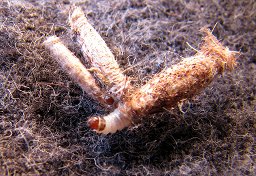MOTHS IN YOUR RUGS
Beware! You could be harboring moths in your area rugs right now! Even if you don't see them flying around.
One day you may even call to have your area rugs picked up to be cleaned only to find out they are full of moth larvae and in desperate need of extensive and expensive repairs.
How could this happen? You vacuum regularly, pick up food bits and sop up spills as quickly as possible. The answer is...There is a dark side to moth infestations (and carpet beetle destruction as well.)
THE DARK SIDE TO
MOTHS IN YOUR RUGS
Moths are insects that love those dark areas we don't get to often enough, such as:
- under and on the back of area rugs on floors and wall-to-wall carpets, especially those with furniture on top of them.
- the backside of area rugs hanging on walls or over banisters.
- under the pet bed (or any other place where pet hair accumulates).
This problem of moths living and eating undetected in the dark places of your home is more widespread than you may realize. As many as 1 in 5 homes across the US are affected. The damage can happen very quickly and if left too long, the damage often cannot be repaired.
With the advent of synthetic fibers, the composition of furniture, rugs and carpets, as well as clothing has significantly changed from wool to synthetic. This fact can lead homeowners to believe 'no wool means no moths.' This is unfortunately not true. If synthetic fibers are soiled and allowed to sit undisturbed, such as under furniture, they too will become a food source that will attract moths.
THE REAL CULPRIT IS THE LARVAE
HOW CAN YOU TELL IF YOU HAVE MOTHS IN YOUR RUGS?
Look for these signs:
- Look for a sticky substance that looks like spiderwebs on the back side of your rugs, a sign of larvae.
- Look for bare spots in your rug where most of the pile has been eaten away. This is especially true if the foundation of your rug is cotton. The moth larvae will eat the wool pile right off the foundation.
- Look for holes or loose carpet pile laying on top of the rug. If the pile of the rug and its foundation is all wool, the insects will eat the rug all the way through.
- Look for the presence of cocoons. They will be lightly fuzzy cylinders, approximately 1/8 inch in diameter x 1/2 inch long, and they will usually be the same color as the pile of the rug. The larvae camouflage their cocoons to blend in with the color of the wool that surrounds them.
HOW CAN YOU AVOID MOTHS IN YOUR RUGS?
- Vacuum rugs regularly, including their backsides. Get to those dark, undisturbed places such as under rugs with furniture on them.
- Springtime, rainy periods, and high humidity are especially good for larvae feeding. Check behind hanging rugs and under your rugs even more carefully during those times.
- Place your area rugs on top of a good quality pad. This can eliminate air spaces between the rug and the floor making it more difficult for the bugs to settle.
- Remove the food source! Have your rugs cleaned regularly and treated with a moth repellent that will make your rug taste bad to the bugs. This is most important when storing a rug. Before storing a rug for any length of time make certain it is properly cleaned and treated.
The best you can do to protect your rugs as well (as your furniture and clothing items), is to be aware of what to look for, vacuum regularly, and have your rugs cleaned and treated every 1 to 3 years.
HAVE YOU FOUND MOTHS IN YOUR RUGS?
If you find evidence of moths in any of your rugs, such as loose pile, bare patches, spidery webs, cocoons, or live larvae, check all of your rugs since larvae can move from rug to rug.
Please call or text our office at 607-272-1566 to service your rugs as soon as you can. For a severe infestation, please call a licensed pest control specialist to rid your home of these pests as soon as possible.
For more in-depth information on moths, please see our articles on Moths, About Moths, and More About Moths.
"The Cleanest Clean You've Ever Seen."
by
ABC Oriental Rug & Carpet Cleaning Co.
130 Cecil Malone Drive Ithaca, NY 14850
607-272-1566









